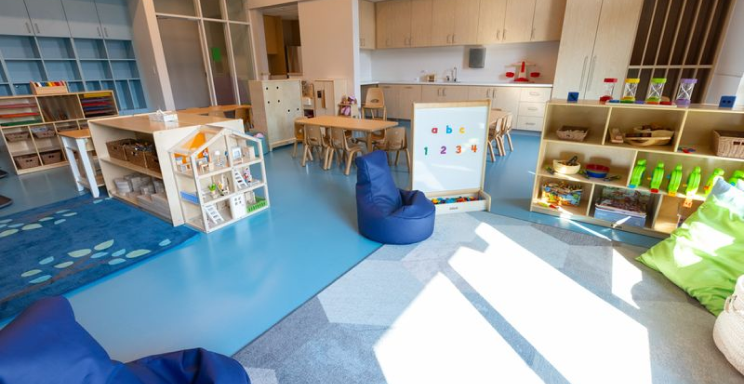“Micron can only succeed in business if we have good people. Child care is a workforce issue, an economic issue and a talent attraction issue. If there’s a barrier keeping someone from working, you have to help remove it.”
-Amanda Blumenstein, Director of People Experience, Micron Technology
Background: Limited Child Care Access Impacts Talent and Productivity
Micron Technology has been a global innovator in semiconductors for over 40 years, powering devices from smartphones to autonomous vehicles. But despite its technical leadership, Micron faces a challenge common to many employers: attracting and retaining talent in the face of inadequate child care access.
By 2019, feedback from their 49,000 employees worldwide made it clear — access to affordable, quality child care was a pressing challenge. In response, Micron began exploring solutions to support employees and engage with child care providers and educators. As they explored potential solutions, company leaders quickly realized the complexities within each child care ecosystem and the need to partner locally in each community. Though it would take some trial and error to find the best solution for each market, Micron’s leaders were committed to supporting their workforce through improved child care options.
Solution: Customizing Child Care Benefits
Micron conducted employee surveys and feasibility studies across several key locations. The results made one thing clear: each community faced different child care challenges. A one-size-fits-all approach wouldn’t work, so Micron launched a range of initiatives tailored to local needs. Here’s how they implemented child care solutions in three U.S. markets and the challenges they faced in each.
Boise, Idaho: On-Site Child Care Center Opens 124 New Slots
Boise, home to Micron’s headquarters, had both a large employee base and limited child care availability. The company partnered with the local YMCA to build a 124-slot on-site center, opening in 2024.
“The YMCA is a great partner because they understand and know our community,” said Marni McDowell, senior director of global wellbeing and experience for Micron. But despite having 150 children on a waitlist for 124 spots, enrollment was slower than expected. Many parents were hesitant to change providers, and the new center wasn’t necessarily convenient for employees commuting from various locations.
“There was a lot of hype about the center, but filling slots takes time,” said Amanda Blumenstein, Micron’s director of people experience. “It’s often new parents who are ready to start with a new child care provider; for others, if your children are happy and settled where they are, it’s less likely that you’ll change your child care situation, even if it’s more challenging.”
Manassas, Virginia: Expanding Backup Care Access
In Virginia, survey data showed that parents’ top concern was backup care: support for when regular care is unavailable due to holidays, school closures or when kids are sick. So, Micron partnered with a national provider to offer access to a backup care network, along with financial assistance for employees.
They soon learned, however, that without a strong local provider network, the benefit fell short. Employees appreciated the financial support but couldn’t always find available care. “You can offer a stipend, but if there’s nowhere to spend it, it doesn’t reduce absenteeism,” said McDowell.
Always open to iteration, Micron is now working with a vendor to expand the local network of backup providers and improve access for employees.
San Jose, California: Reserving Child Care Slots for Employees
In the Bay Area, Micron piloted a slot-reservation model, paying providers to move employees to the top of waitlists. But the model lacked flexibility; families couldn’t choose their preferred provider, and reserved (and paid for) spots often went unused.
Despite a three-year commitment, Micron ended the program early. “Even with good intentions, we learned that guaranteed access doesn’t mean guaranteed usage,” said McDowell.
Results: Tailored Child Care Solutions Earn Trust
Though Micron encountered challenges in each of these scenarios, they succeeded in improving options for many employees. And they’ve learned a lot through the process.
Micron’s multisite approach has created meaningful goodwill across its global workforce. While some initiatives are still evolving, the company sees its investments in child care as essential to retention and competitiveness. “We’re in a competitive industry employing highly talented people,” said Blumenstein. “When we provide child care support resources that our employees value, it influences their decision to stay with the company.”
While leaders are still gathering long term data, Micron’s employees have expressed appreciation for their attempting meaningful, customized solutions. Leaders expect a return on investment for these efforts and will continue to adapt plans as they test and learn for each site.
Blumenstein and McDowell’s Advice to Business Leaders
Adapt and Iterate
Micron continuously revisits its employee data to refine benefits and replace ineffective strategies. “You have to be willing to change course when something isn’t working,” said McDowell. “We’ve hit some snags along the way, but we’ve never given up on our commitment to improving our employees’ ability to care for their families.”
Collaborate Locally
“The key is working with your workforce and your local child care ecosystem,” said McDowell. “You need to understand the pain points to make meaningful change.”
Be Inclusive
“We’re not in the business of child care, but we are in the business of taking care of our team members and their families,” says McDowell. “Enriching life for all” is an anchor for the company’s vision, and that means focusing on an inclusive environment. “With how niche some of our roles are, it could be that there are only 10 people in the world who can fill the role. If they don’t have care for their child, then we have to help them find solutions,” Blumenstein says.
Lead by Example
“This isn’t just a family issue — it’s a workforce issue,” added Blumenstein. “Employers need to be vocal about their needs and efforts and lead by example. To other business leaders, we say: Join us!”


